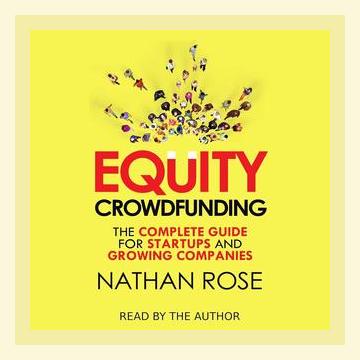Entrepreneurship and StartupsFunding and Investment
f “Equity Crowdfunding: The Complete Guide for Startups and Investors” by Nathan Rose:
Title: Equity Crowdfunding: The Complete Guide for Startups and Investors
Author: Nathan Rose
Year: 2016
Categories: Funding, Investment
Introduction
Nathan Rose’s “Equity Crowdfunding: The Complete Guide for Startups and Investors” provides a detailed roadmap for both startups seeking funding and investors looking for high-potential opportunities. Rose elucidates the concept of equity crowdfunding, its mechanisms, and offers practical advice for successful campaigns.
1. Understanding Equity Crowdfunding
Definition and Mechanism
– Equity Crowdfunding involves raising capital from a large number of investors through online platforms, with each investor receiving shares in return.
– Example: In 2013, Oculus Rift raised $2.4 million through Kickstarter, which contributed to their later $2 billion acquisition by Facebook.
Action for Startups:
– Open an account on a reliable equity crowdfunding platform like Seedrs or Crowdcube. Learn the platform’s requirements and how they align with your fundraising goals.
2. The Evolution of Crowdfunding
Historical Context
– Originally gaining traction with rewards-based crowdfunding (like Kickstarter and Indiegogo), equity crowdfunding developed as legislations such as the JOBS Act in the US were passed, allowing unaccredited investors to participate.
Action for Investors:
– Stay informed about current laws and regulations in your country to understand your rights and limitations in equity crowdfunding.
3. The Benefits and Risks of Equity Crowdfunding
Benefits for Startups
– Access to Capital: Easier access to a large pool of potential investors.
– Marketing Boost: Campaigns act as marketing tools.
– Validation: Successful funding demonstrates market demand.
Risks for Startups
– Dilution of Control: With more investors, the control over the company may be diluted.
– Disclosure Requirements: Necessity to share business plans and financials publicly.
Action for Startups:
– Prepare comprehensive financial and business plans to present to potential investors.
Benefits for Investors
– Diverse Portfolio: Opportunity to diversify their investment portfolio.
– High Returns: Potential for high returns if the startup succeeds.
Risks for Investors
– High Risk: High potential for loss, especially with startups.
– Illiquidity: Difficulty in selling shares before a company goes public or is acquired.
Action for Investors:
– Conduct thorough due diligence before investing, assessing the business model, team, market size, and financial health.
4. Preparing for a Crowdfunding Campaign
Business Plan and Financials
– A detailed and clear business plan is crucial. It should include market analysis, competitive landscape, revenue model, and financial projections.
– Example: BrewDog, a craft beer company, raised over £7 million in a series of equity crowdfunding rounds by presenting a clear growth strategy and strong brand story.
Pitch Materials
– Developing compelling pitch materials is vital which include a strong video, a clear value proposition, and marketing messages.
– Example: Monzo Bank’s pitch included a professional video that articulated their aim to revolutionize banking, which helped raise £1 million in 96 seconds.
Action for Startups:
– Invest time and resources in creating high-quality pitch materials including video content, detailed pitch decks, and engaging copy.
5. Conducting a Successful Crowdfunding Campaign
Building a Community
– Engage your community before launching the campaign. Use social media, email newsletters, and press releases to build momentum.
– Example: Pebble watch’s success in crowdfunding was partly due to their active community engagement long before their launch.
Setting Realistic Goals
– Ensure your funding goals are realistic and achievable within the campaign timeframe. Overambitious goals can deter potential backers.
– Action for Startups: Set a funding goal that balances the amount needed with what you can realistically raise based on your network and marketing efforts.
Leveraging Multiple Platforms
– Utilizing multiple crowdfunding platforms and channels can enhance visibility and funding opportunities.
– Example: Cross-platform campaigns such as those seen with the company Seedrs, utilising social media and influencer endorsements.
Maintaining Transparency
– Transparent communication throughout the campaign builds trust and encourages investor engagement.
– Action for Startups: Regularly update backers on campaign progress and future milestones via platform updates, email newsletters, and social media.
6. Post-Campaign Strategies
Executing the Plan
– Post-campaign, focus on executing the plans outlined to investors and maintain regular communication with them.
– Action for Startups: Create and stick to a timeline to implement your business milestones.
Managing Investor Relations
– Build a structured communication strategy to keep investors informed about progress, challenges, and future plans.
Example: Swappable maintained continuous communication with their investors through quarterly updates and financial reports to keep them informed and engaged.
Action for Startups:
– Develop a post-campaign communication plan, including regular updates, financial reporting, and future fundraising plans.
7. Long-term Considerations for Investors
Portfolio Management
– Diversify investments across different sectors to minimize risk.
Example: An investor might spread investments across tech startups, bio-tech firms, and consumer goods companies.
Exiting Investments
– Understand different exit strategy possibilities including acquisitions, IPOs, or secondary market sales.
Action for Investors:
– Monitor performance regularly and set criteria for exit to make informed decisions about holding or selling shares.
Conclusion
Nathan Rose’s comprehensive guide illuminates not only the pathways but also the nuanced strategies for both startups and investors in the equity crowdfunding space. Emphasizing preparation, community engagement, realistic milestones, and transparency, the book serves as a critical resource for anyone looking to navigate the equity crowdfunding landscape successfully.
This structured summary highlights the key components of Nathan Rose’s book, providing specific actions for both startups and investors based on the advice in the book along with real-world examples for clarity.
